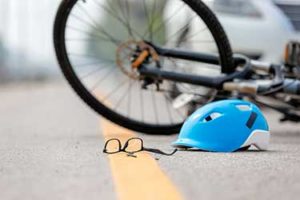
The sun is shining, and the cool breeze hits your face as you pedal through the streets of California. But amidst the joy of cycling, an unexpected incident can leave you questioning your rights and responsibilities as a cyclist. Understanding California bicycle laws helps you stay safe and empowers you to protect your rights if an accident occurs.
The Basics of Bicycle Laws in California
California’s bicycle laws ensure the safety of cyclists, pedestrians, and motorists alike. The following is what you need to know about your legal responsibilities and protections as a cyclist in the state:
- Bicycles are considered vehicles. Under California law, cyclists have the same rights and responsibilities as drivers. This includes following traffic signals, yielding to pedestrians, and riding in the same direction as traffic.
- California bicycle helmet laws. While not all cyclists are legally required to wear helmets, the state’s bike helmet laws mandate that anyone under 18 must wear an approved helmet while riding. Wearing a helmet is not only a legal requirement for minors but also a crucial safety measure for all riders.
- Lighting and equipment requirements. Cyclists must equip their bikes with a rear red reflector or light, a front white light visible from 300 feet, and reflectors on their pedals. These requirements ensure that cyclists are visible to drivers and pedestrians during low-light conditions.
- Prohibited actions. California law prohibits cyclists from riding while under the influence of alcohol or drugs. Cyclists also cannot hold onto moving vehicles or use headphones while cycling.
- Obeying traffic signals. Like motorists, cyclists must obey all traffic signals and signs. Running a red light or failing to stop at a stop sign can lead to accidents and legal consequences.
- Yielding to pedestrians. Cyclists must yield to pedestrians in crosswalks and exercise caution in areas with high foot traffic. This ensures the safety of everyone sharing the road.
- Riding two abreast. While cyclists are generally permitted to ride side by side, they must do so without obstructing traffic. When it is unsafe to ride two abreast, cyclists should ride single file.
California imposes significant responsibilities on bicyclists. These responsibilities are designed to protect all riders and reduce the likelihood of a devastating accident. Violating these protections can result in fines, penalties, and legal liability.
What Are the Bicycle Laws in California Regarding Accidents?
In the event of a bicycle accident, California law requires the involved parties to:
- Stop at the scene,
- Exchange contact and insurance information, and
- Report the accident to law enforcement if injuries or significant property damage occur.
If you’ve been in an accident, documenting the scene and gathering witness statements can be invaluable for building a potential legal claim.
Bicycle Safety Laws to Protect Cyclists
California has implemented several measures to reduce accidents and injuries. These measures focus on allowing bicycles to share the road with motor vehicles safely. Some of the more common safety laws include:
- The move-over rule. This rule states that motorists must move over at least one lane when passing a cyclist. Failure to comply can result in fines and increased liability in the event of an accident.
- Distracted driving laws. These laws prohibit drivers from using handheld devices while driving, reducing the risk of collisions with cyclists.
- Safe intersection practices. Cyclists should exercise extra caution at intersections, where most bicycle accidents occur. Using hand signals to indicate turns and being aware of turning vehicles are essential for intersection safety.
Following these laws can help cyclists and the motorists they share the road with to reduce the risk of an accident causing serious injuries.
Steps Cyclists Can Take to Stay Safe and Protect Their Rights
While accidents can happen, you can reduce risks and strengthen your legal position by:
- Wearing proper gear—wear a certified helmet and bright, reflective clothing to enhance safety and visibility;
- Following traffic laws—adhere to all traffic rules and ride predictably;
- Documenting incidents—if involved in an accident, take photos, gather information, and report the event promptly; and
- Getting legal advice—consulting an attorney can clarify your rights and next steps.
Staying proactive and well-informed is essential to prioritizing your safety and safeguarding your rights in case of an accident.
How The Beliz Law Firm Can Help Cyclists in California
Understanding California law may seem overwhelming if you’ve suffered a bicycle accident. Our firm brings years of experience and a client-first approach to ensure you get the support you deserve. Clients choose us for the following reasons:
- We investigate accident scenes, gather witness statements, and analyze evidence to establish fault;
- We counter lowball offers from insurance companies attempting to minimize your payout with strong advocacy;
- From medical bills to lost wages and pain and suffering, we fight for the full compensation you deserve; and
- We’ll guide you through every step of the legal process, safeguarding your rights using our understanding of California bicycle laws.
Our firm has successfully recovered millions of dollars in compensation for our clients. With us, you’re not just a cyclist but a fighter for justice.
Don’t Let a Cycling Accident Halt Your Ride
Every cyclist deserves to ride confidently, knowing the law has their back. The Beliz Law Firm ensures your voice is heard and your rights are protected. If you’ve been injured in a bicycle accident, don’t let uncertainty keep you from seeking justice. Michael A. Beliz, a trusted advocate with years of experience, can guide you through the legal maze with compassion and determination. Contact us today for a free consultation to begin your journey toward justice.
Frequently Asked Questions
Can I Ride My Bike on Sidewalks in California?
California law allows local jurisdictions to determine sidewalk cycling rules. In many cities, business districts prohibit or restrict cycling on sidewalks. Check your local ordinances to stay compliant.
Are Electric Bikes Subject to the Same Laws as Regular Bicycles?
Electric bikes (e-bikes) in California are generally subject to the same regulations as traditional bicycles. However, certain classifications of e-bikes may have additional requirements, such as speed limits and licensing restrictions.
What Should I Do If I’m Involved in a Hit-And-Run While Cycling?
If you’re the victim of a hit-and-run, report the incident to the police immediately and seek medical attention. Gathering evidence, such as license plate numbers and vehicle descriptions, can help authorities and your attorney.
